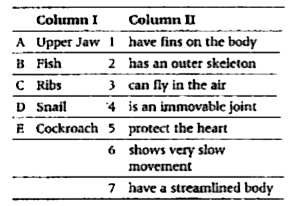Match items in Column A with one or more items in Column B.
Column AColumn B(i)The planet which is(a)Star farthest from the Sun(ii)The planet which(b)Earth appears reddish in colour(iii)Artificial satellite(c)Orion(iv)Inner planets(d)Mercury(v)Outer planets(e)INSAT(vi)Natural satellite of the Earth(f)Neptune(vii)Constellation(g)Mars(viii)A celestial body emitting(h)Great Bear heat and light(ix)Smallest planet in the(i)Moon solar system(x)Fastest orbiting planet(j)Jupiter
To match the items in Column A with one or more items in Column B, we will analyze each item in Column A and find the corresponding items in Column B.
1. The planet which is farthest from the Sun:
- The planet that is farthest from the Sun is Neptune.
- Match: (i) → (f)
2. The planet which appears reddish in color:
- The planet known as the "Red Planet" is Mars.
- Match: (ii) → (g)
3. Artificial satellite:
- An example of an artificial satellite is INSAT.
- Match: (iii) → (e)
4. Inner planets:
- The inner planets are Mercury, Venus, Earth, and Mars. Since Venus is not listed, we will match the available inner planets.
- Match: (iv) → (d), (b), (g) (Mercury, Earth, Mars)
5. Outer planets:
- The outer planets include Jupiter, Saturn, Uranus, and Neptune. We can match the available outer planets.
- Match: (v) → (j), (f) (Jupiter, Neptune)
6. Natural satellite of the Earth:
- The only natural satellite of Earth is the Moon.
- Match: (vi) → (i)
7. Constellation:
- Two well-known constellations are Orion and Great Bear.
- Match: (vii) → (c), (h) (Orion, Great Bear)
8. A celestial body emitting heat and light:
- The celestial bodies that emit heat and light are Stars.
- Match: (viii) → (a)
9. Smallest planet in the solar system:
- The smallest planet is Mercury.
- Match: (ix) → (d)
10. Fastest orbiting planet:
- The fastest orbiting planet around the Sun is Mercury.
- Match: (x) → (d)
Final Matches:
- (i) → (f) Neptune
- (ii) → (g) Mars
- (iii) → (e) INSAT
- (iv) → (d) Mercury, (b) Earth, (g) Mars
- (v) → (j) Jupiter, (f) Neptune
- (vi) → (i) Moon
- (vii) → (c) Orion, (h) Great Bear
- (viii) → (a) Star
- (ix) → (d) Mercury
- (x) → (d) Mercury
- The planet that is farthest from the Sun is Neptune.
- Match: (i) → (f)
- The planet known as the "Red Planet" is Mars.
- Match: (ii) → (g)
- An example of an artificial satellite is INSAT.
- Match: (iii) → (e)
- The inner planets are Mercury, Venus, Earth, and Mars. Since Venus is not listed, we will match the available inner planets.
- Match: (iv) → (d), (b), (g) (Mercury, Earth, Mars)
- The outer planets include Jupiter, Saturn, Uranus, and Neptune. We can match the available outer planets.
- Match: (v) → (j), (f) (Jupiter, Neptune)
- The only natural satellite of Earth is the Moon.
- Match: (vi) → (i)
- Two well-known constellations are Orion and Great Bear.
- Match: (vii) → (c), (h) (Orion, Great Bear)
- The celestial bodies that emit heat and light are Stars.
- Match: (viii) → (a)
- The smallest planet is Mercury.
- Match: (ix) → (d)
- The fastest orbiting planet around the Sun is Mercury.
- Match: (x) → (d)
- (i) → (f) Neptune
- (ii) → (g) Mars
- (iii) → (e) INSAT
- (iv) → (d) Mercury, (b) Earth, (g) Mars
- (v) → (j) Jupiter, (f) Neptune
- (vi) → (i) Moon
- (vii) → (c) Orion, (h) Great Bear
- (viii) → (a) Star
- (ix) → (d) Mercury
- (x) → (d) Mercury
Similar Questions
Knowledge Check
Match the items in Column I with one or more items of Column II.
 AABCDE47,1563,2BABCDE71,53,257,1CABCDE463,257,1DABCDE651,743,2
AABCDE47,1563,2BABCDE71,53,257,1CABCDE463,257,1DABCDE651,743,2Match the items in Column I with one or more items of Column II.
 AABCDE47,1563,2BABCDE71,53,264CABCDE463,257,1DABCDE651,743,2
AABCDE47,1563,2BABCDE71,53,264CABCDE463,257,1DABCDE651,743,2Match items in Column I with Column II
 AA-1,B2-,C-3,D-4BA-3,B-1,C-2,D-4CA-4,B-1,C-2,D-3DA-4,B-3,C-2,D-1
AA-1,B2-,C-3,D-4BA-3,B-1,C-2,D-4CA-4,B-1,C-2,D-3DA-4,B-3,C-2,D-1
Match the Items given in column I with one or more items of column II.

View SolutionMatch items in Column A with those in Column B.

View SolutionMatch items in Column A with those in Column B.

View SolutionMatch the items in column A with suitable ones in column B :

View SolutionMatch the items in column A with suitable terms in column B:
View Solution

